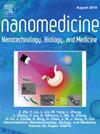Silver nanoparticles enhance neutron radiation sensitivity in cancer cells: An in vitro study
IF 4.6
2区 医学
Q2 MEDICINE, RESEARCH & EXPERIMENTAL
Nanomedicine : nanotechnology, biology, and medicine
Pub Date : 2025-02-28
DOI:10.1016/j.nano.2025.102813
引用次数: 0
Abstract
Growing interest in cancer radiotherapy has led to the application of nanoparticles as radiosensitizers. Here, we, for the first time, present the results of the radiosensitizing properties of silver nanoparticles (AgNPs) (possessing low toxicity towards human body) against cancer cells under neutron irradiation. Five standard cancer cultures (including glioblastoma, known for its resistance to conventional photon radiation) were used to evaluate the radiosensitizing properties of AgNPs suing MTT test, flow cytometry, and optical fluorescence microscopy. Neutron irradiation was applied in the absorbed dose of 0.5–1.5 Gy with an average neutron energy of 7.5 MeV. AgNPs increased the irradiation efficiency with the radiosensitivity enhancement ratios 1.02–2.32, for glioblastoma with ratios 1.22–1.47. It was revealed that at 1.5 Gy, AgNP-induced cytotoxicity made a significant contribution to the total observed radiosensitizer effect: on average, for five cell types, 29.8 and 96.2 % at the AgNP concentration of 0.2 and 1.6 μg/mL, respectively.

银纳米粒子增强癌细胞中子辐射敏感性:一项体外研究。
对癌症放射治疗日益增长的兴趣导致纳米颗粒作为放射增敏剂的应用。本文首次报道了银纳米粒子(AgNPs)(对人体毒性较低)在中子照射下对癌细胞的放射增敏特性。五种标准癌症培养物(包括胶质母细胞瘤,以其对常规光子辐射的抗性而闻名)使用MTT试验、流式细胞术和光学荧光显微镜来评估AgNPs的放射增敏特性。中子辐照吸收剂量为0.5 ~ 1.5 Gy,平均中子能量为7.5 MeV。AgNPs对胶质母细胞瘤的放射敏感性增强比为1.02 ~ 2.32,对胶质母细胞瘤的放射敏感性增强比为1.22 ~ 1.47。结果表明,在1.5 Gy时,AgNP诱导的细胞毒性对观察到的总放射增敏效应有显著贡献:平均而言,在AgNP浓度为0.2和1.6 μg/mL时,五种细胞类型的细胞毒性分别为29.8%和96.2 %。
本文章由计算机程序翻译,如有差异,请以英文原文为准。
求助全文
约1分钟内获得全文
求助全文
来源期刊
CiteScore
11.10
自引率
0.00%
发文量
133
审稿时长
42 days
期刊介绍:
The mission of Nanomedicine: Nanotechnology, Biology, and Medicine (Nanomedicine: NBM) is to promote the emerging interdisciplinary field of nanomedicine.
Nanomedicine: NBM is an international, peer-reviewed journal presenting novel, significant, and interdisciplinary theoretical and experimental results related to nanoscience and nanotechnology in the life and health sciences. Content includes basic, translational, and clinical research addressing diagnosis, treatment, monitoring, prediction, and prevention of diseases.

 求助内容:
求助内容: 应助结果提醒方式:
应助结果提醒方式:


